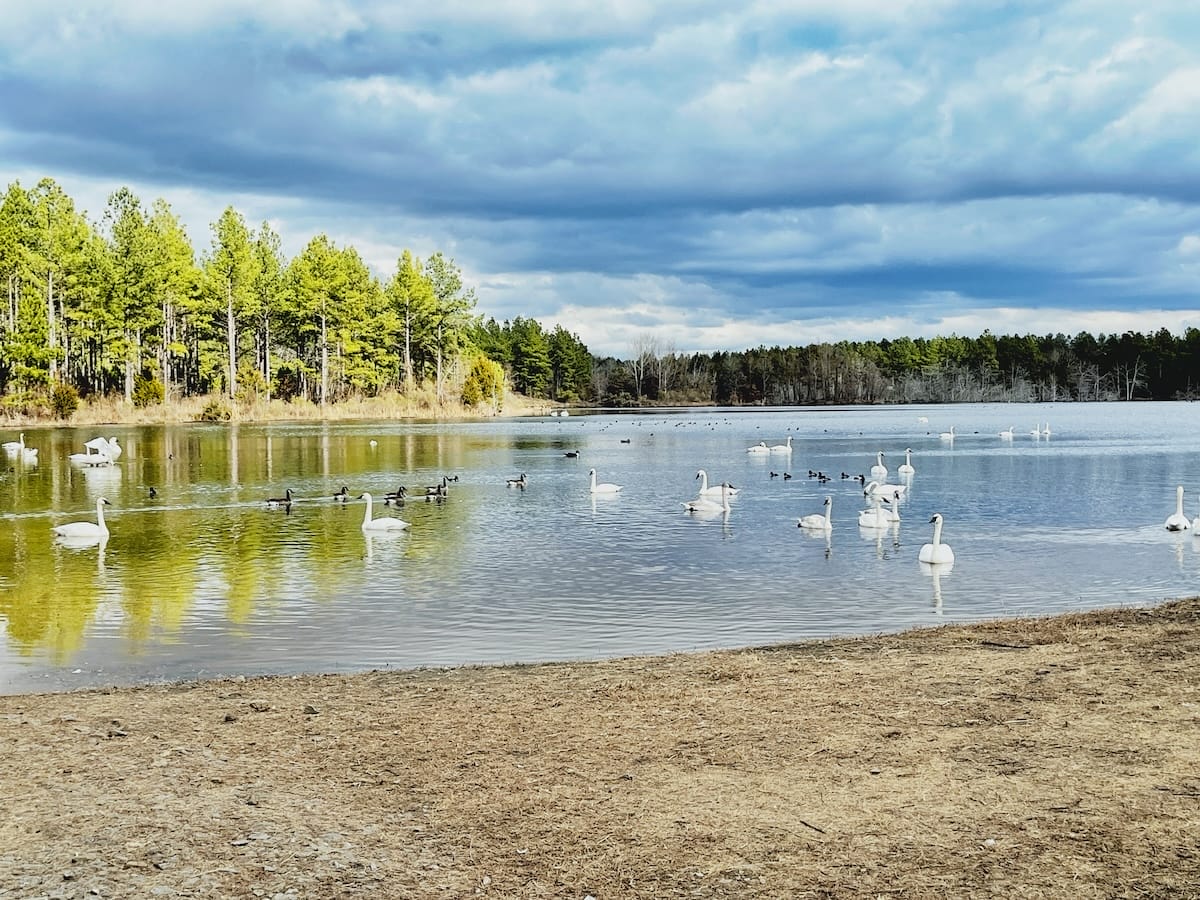

Uh oh...
It appears that you're using a severely outdated version of Safari on Windows. Many features won't work correctly, and functionality can't be guaranteed. Please try viewing this website in Edge, Mozilla, Chrome, or another modern browser. Sorry for any inconvenience this may have caused!
Read More about this safari issue.

Thirty-four years ago, an unexpected event captured the attention of scientists and bird enthusiasts alike: three Trumpeter Swans touched down on Magness Lake near Heber Springs, Arkansas, sometime between December 30, 1990, and January 12, 1991. These majestic birds, unaccustomed to venturing so far south, were likely driven off course by a severe snowstorm. Against all odds, the trio thrived through the winter before presumably returning to their northern breeding grounds in spring. No one expected their return, but the following winter, they did—and they weren’t alone.
In January 1992, the original mating pair returned, accompanied by several cygnets (juvenile swans). Each year, their numbers grew until the mid-2000s, when approximately 200 Trumpeter Swans made the annual journey to Magness Lake. The swans quickly became a cherished part of the local culture, drawing thousands of visitors to the small viewing area on the lake’s southern edge.

During the day, small groups of swans venture up to 50 miles to feed on vegetation in nearby lakes, ponds, and fields. While occasional sightings elsewhere are expected, an unusual development occurred around 2011. C. Verlon Abram, who lived about four miles from Magness Lake on Hiram Road, noticed a growing number of swans flocking to a pond he had recently excavated. Thrilled by their presence, Abram began feeding the swans and visiting them twice daily. Recognizing their growing attachment to his property, he decided to open his gates so others could share in the experience.

Abram’s’ dedication to the swans extended beyond hosting them; he covered the considerable cost of their supplemental feed, which required 6-10 tons of corn annually. His passion for the birds became a labor of love. As Abram’s health declined, his friend Terry Butler, who had first discovered the swans on Magness Lake, stepped in to assist. Butler took on responsibilities such as filling feeders, managing visitor traffic, and monitoring the swans—all while setting up donation boxes to help offset the feeding expenses. Butler’s deep connection to the swans earned him recognition as the state’s leading expert on them.
In recent years, as Butler’s health also began to falter, retired schoolteacher Kenny Nations stepped up to continue the work. Nations has since taken over most of the operations, deepening his expertise on the swans while maintaining the tradition of welcoming visitors to the ponds. The Trumpeter Swans have not only brought joy to the local community but have also garnered national attention. Organizations like The Trumpeter Swan Society, the Arkansas Game and Fish Commission, and researchers from several universities have shown keen interest in the swans’ story. Last year, Nations shared his knowledge during a webinar organized by The Trumpeter Swan Society titled “Trumpeter Swans Southern Flock: The Arkansas Swan Story.”
Visitors to the Hiram Road ponds last year may have noticed new signs dedicated to the memory of C. Verlon Abram, who passed away in September 2023. After his funeral, Butler and Nations swiftly collaborated to install the signs, ensuring Abram’s legacy lives on. Thanks to Abram’s foresight and the continued efforts of Butler and Nations, the ponds, which now serve as the winter home to nearly 400 swans, remain open to the public, welcoming swans and admirers alike each year as the first birds arrive.

Frequently Asked Questions
Where can I see the swans?
The swans are most prevalent at Magness Lake on Hays Road and the two ponds located on Hiram Road. The Hiram Road ponds are marked with swan signs.
When do the swans arrive?
The swans begin arriving in mid to late November and stay through mid-February. Thanksgiving to Valentine’s is an easy way to remember. The migration comes in phases, and most of the 300-400 swans arrive in late December and Early January when northern ponds begin to freeze over, cutting off their natural food supply.

Where do the swans migrate from?
Swans with tracking tags and collars are monitored closely, and swans have come from Iowa, Michigan, Minnesota, and Wisconsin, as well as Ontario and Manitoba, Canada, to spend the winter in Arkansas. We even get a few Tundra Swans, including one that is tracked all the way from Alaska.
Can I bring food for the swans?
While you can bring deer corn for the swans, Nations says it’s likely much easier to drop a few dollars into the donation box and just grab a handful or two from the feeders located next to the ponds. When you toss the corn, toss it on the edge of the water rather than in deeper water where the swans can’t reach it and it will go to waste.
Do NOT bring bread for the swans. Bread does not contain proper nutrients and can lead to health issues for the swans.
Can I bring my dog?
Nations recognizes that pets are like family members to many people, but your pets need to stay in the car while you observe the swans. For their safety, swans must maintain a healthy fear of other animals. While your fur baby may not attack a swan, regular exposure to dogs can diminish their fear, making them vulnerable to attacks from natural predators like coyotes and bobcats.
We do the work.
You check your email.
Sign up for our weekly e-news.
Get stories sent straight to your inbox!









Like this story? Read more from Julie Kohl
Life in Arkansas’s early 20th-century company towns revolved around...
December in Arkansas brings a peaceful mix of chilly mornings, bright...
The holidays can be a joyful time, but they can also be difficult for...
Join the Conversation
Leave a Comment